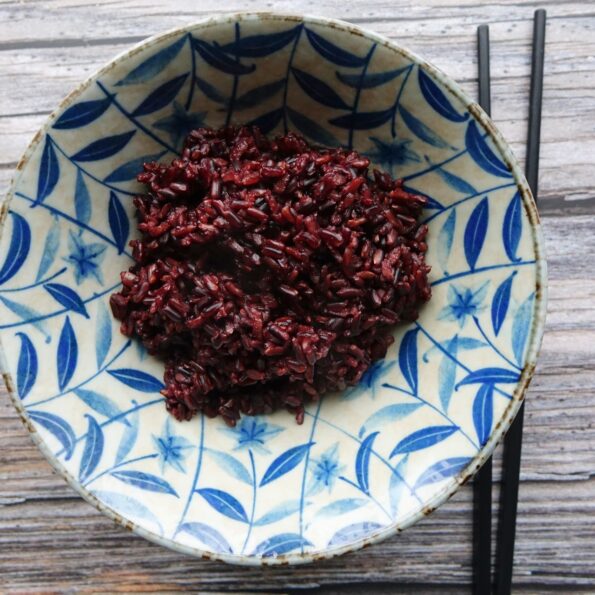
- Servings 3
- Prep 15 min
- Cooking 25 min
Calories: 188 kcal Protein: 4.3 g Fat: 1.2 g Saturated Fat: 0.2 g
Carbohydrates: 38 g Dietary Fiber: 2.4 g Sugars: 0.1 Cholesterol: 0 mg
Sodium: 2 mg
- One cup of Riceberry rice
- Two cups of water
- Pinch of salt
- Sesame oil or butter to taste (optional)
- Measuring Cups
- Rice Washer or Fine Mesh Strainer
- Saucepan with Lid
- Wooden Spoon or Rice Paddle
- Timer or Clock
- Colander
- Place the Riceberry rice in a fine-mesh strainer or sieve.
- Rinse the rice under cold running water until the water runs clear. This process removes excess starch and prevents the rice from becoming too sticky
- If you have the time, you can soak the rice in cold water for about 30 minutes. This helps the rice cook more evenly and become fluffier. Drain after soaking.
- For one cup of Riceberry rice, use two cups of water. Adjust the amount of water slightly to achieve your desired rice texture; however, a 1:2 ratio is a good starting point.
- Bring the measured water and a pinch of salt to a boil over medium-high heat in a saucepan or pot.
- Stir in the rinsed and drained Riceberry rice into the boiling water.
- Reduce the heat to low to maintain a gentle simmer.
- Place a tight-fitting lid on the pot to trap steam and let the rice simmer for about 20-25 minutes. Check the package instructions for specific cooking times, as they vary slightly
- After the cooking time is complete, remove the pot from the heat, but keep the lid on.
- Let the rice rest for 5-10 minutes, allowing the steam to be distributed evenly, making the rice fluffy.
- Use a fork to fluff the rice, gently separating the grains.
- Add sesame oil.
Your perfectly cooked Riceberry rice is ready to serve. This rice is a delightful and nutty addition to any meal, whether as a side dish, stir-fry, or as the base for a delicious bowl.
Riceberry rice is considered a superfood due to its high content of antioxidants. Its rich purple pigment is associated with over 80 antioxidant compounds, contributing to its health benefits, including promoting heart health and reducing the risk of chronic diseases.
Riceberry rice is not just a nutritional powerhouse, but also a versatile ingredient in the kitchen. It offers a unique nutty flavor, savory and slightly sweet taste, and a fruity fragrance. Whether served as a standalone dish, lightly seasoned, or as a complement to various main dishes, its distinct flavor and nutritional benefits can be enjoyed in a variety of culinary creations.
An alternative method involves combining Riceberry and jasmine rice in a pot with water. Bring the mixture to a boil, then reduce the heat and let it simmer for about 30 minutes. This method blends the unique flavors and textures of both rice varieties.
Discover How to Cook Riceberry rice with our simple and comprehensive guide!
In ancient China, Riceberry or Black rice was not available to ordinary people and was consumed only by aristocrats. The inhabitants of the Celestial Empire considered it a source of eternal youth and cereal that enriches the blood with essential vitamins and minerals. The nutritional value and benefits of eating black rice are several times higher than the white counterpart. It is rich in antioxidants, and contains protein, vitamins B and E, and folic acid.
In particular, Riceberry rice has a warm aromatic smell and sweetish taste, which has a subtle admixture of nutty notes.
